欧博allbetAnimals in Serengeti: What wildlife can be
Serengeti is also home to a large number of other animals apart from the Big Five or Big Nine. This is a list of some of the other diverse wildlife you will find in Serengeti National Park , starting with a list of Mammals below.
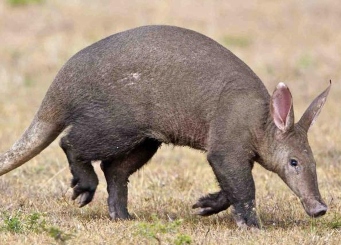
Aardvark ( Orycteropus afer )
The Aardvark (Orycteropus afer) is a small to medium sized burrowing mammal with a long snout and powerful claws, native to Africa. Aardvarks are nocturnal animals and feed on insects, mainly ants and termites. They have a hairless body with a pronounced arched back and short legs. The thick claws on the forefeet are well adapted for burrowing and digging.
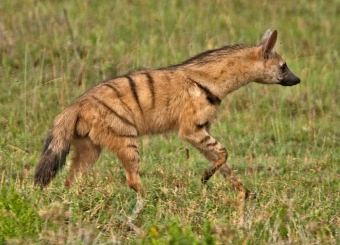
Aardwolf ( Proteles cristatus )
Aardwolf "proteles cristatus" is an insectivorous carnivore, native to East and Southern Africa. Its name means "earth wolf" in Afrikaans. It is yellowish with vertical black stripes and a bushy black-tipped tail and resembles a small striped hyena. Like the hyena, it has a long coarse ridge of erectile hairs along the length of the back, sturdy shoulders, and longer front than hind legs. However, Aardwolf is less of a runner and has five toes on the front feet instead of four. Aardwolves are found on the open, grassy plains of east and south Africa. They are solitary and they rest in burrows during the day before becoming active at night. Their territory is between 1 and 4 square kilometres, depending on food availability, and they mark it with urine, dung and secretions from their anal glands.
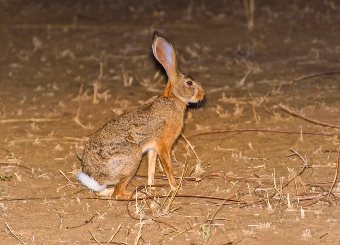
African Hare ( Lepus capensis )
African hares are commonly found in grasslands and wooded savannas throughout in Africa. They live mainly solitary lives, though they sometimes form groups of two or three when eating and use their senses of hearing, smell, and sight to avoid predators. African hares are 20 inches long, weighs between 1.5 to 3 kilograms (3.3 to 6.6 lb) and feeds on leaves, buds, roots, berries, fungi, bark and twigs. African hares are generally present in Serengeti National Park. The life span of the African hare is 12 years.
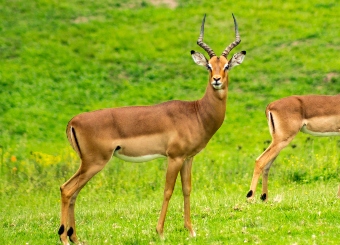
Antelope ( Alcelaphinae )
One of the wild animals that most people would always associate with East Africa, Antelopes are present in Serengeti and Tanzania generally in large numbers. There are 3 sub species, namely the Kirk's Dik-Dik, klipspringer, and Oribi Antelope. Antelope are found on arid regions with bush or scrub cover and come in a variety of sizes and show true diversity and imagination with their head gear. They’re the unsung beauties of the bush and the grassland.
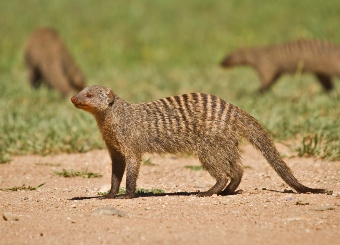
Banded Mongoose ( Mungos mungo )
Banded mongoose is a mongoose commonly found in the central and eastern parts of Africa. It lives in savannas, open forests and grasslands and feeds primarily on beetles and millipedes. Mongooses use various types of dens for shelter including termite mounds and they live in colonies with a complex social structure. They are brown or grey in colour and are easily identifiable by the dark bands across the back which stretch from shoulder to the tail. The animal is about 40 cm in length and weighs btween 1.3 to 2.3 kg. They are commonly seen in groups in Serengeti National Park.
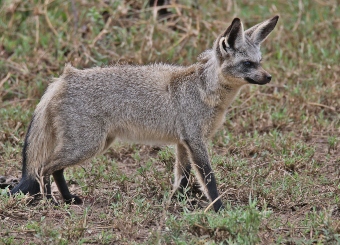
Bat Eared Fox ( Otocyon magalotis )
Bat eared fox is a species of fox found on short-grass prairies and arid grasslands and are only found in Africa, where they are most often seen foraging at night or in the early morning in warmer months and during the day when the weather turns colder. Its body is generally yellow-brown; the throat and underparts are pale. Often seen in areas that have been extensively grazed by domestic and wild ungulates, but they do venture into tall grass and thick shrub areas if threatened. They are highly social so if you spot one, keep your eye out for more. Majority of the bat-eared fox’s diet consists of small invertebrates such as ants, termites, spiders, scorpions and crickets. They will also eat small birds, mammals and reptiles, and even desert truffle.

Bushbaby ( Galago senegalensis )
Bushbaby also known as the Senegal galago, the lesser galago or the lesser bush baby, is a small arboreal and nocturnal primates with large round eyes that are good for night vision and exceptionally fine hearing ability. They have strong back legs that enable them to jump more than 5-6 feet in a vertical direction. They are agile, speedy climbers and their long tails give them added balance. They are gentle furry creatures that feed in seeds, nuts, fruits, flowers and insects. It is found in all major reserves particularly Serengeti National Park.

Bushbuck ( Tragelaphus scriptus )
Bushbuck also known as Imbabala, is a sub-Saharan antelope found in rain forests, montane forests, forest-savanna mosaics and bush savannas. Bushbucks have a light brown coat, with up to seven white stripes and white splotches on the sides. The muzzle is also white and horns are found only on the males and they can reach over half a meter with only one twist. They mainly browse, but supplement their diet with any other plant matter that they can reach. Bushbucks are active around 24 hours a day, but tend to be nocturnal near human habitations.

Coke's Hartebeest ( Alcelaphus buselaphus cokii )
The Coke's Hartebeest is a medium-sized, fawn-colored antelope. It is easy to recognise as it has long, narrow face and distinctively angular short horns (on both sexes) which are heavily ridged. They are mainly found in medium and tall grasslands, including savannas. They can be easily spotted in Nyerere National Park, Ngorongoro Crater, and Serengeti National Park. It is one of the fastest antelopes and most enduring runners. The hartebeest feeds almost entirely on grass, but is not very selective and quite tolerant of poor-quality food.
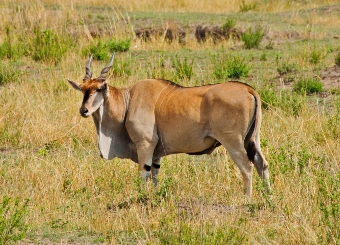
Common Eland ( Taurotragus oryx )
Also known as the southern eland or eland antelope, is a savannah and plains antelope found in East and Southern Africa. It is the second largest antelope in the world, being slightly smaller on average than the giant eland. Common eland are spiral-horned antelopes. They prefers savannah scrub to wide open spaces, but also avoids thick forest. It feeds on grass and tree foliage in the early morning and late afternoon, and is also active on moonlit nights. They are easily seen Nyerere National Park, Ngorongoro Crater, and Serengeti National Park.

Copper Tailed Monkey/ Red Tailed Monkey ( Cercopithecus ascanius )
Also known as copper tailed monkeys, found in East and Central Africa. They are social primates that form groups of 7-30 individuals.The groups consist of one dominant male and females and their offspring. Groups generally stay together throughout the day and through life, except for males who reach maturity. Red-tailed monkeys are more active in the early morning and evening. They communicate physically, vocally, visually and also demonstrate social dominance, submissiveness, or greeting. They are omnivorous and feed on fruits but also eat leaves, flowers, or insects in times where fruit is scarce.

Crested Porcupine ( Hystrix cristata )
Crested Porcupine is a very large, black-bodied, nocturnal rodent with long, black and white spines and a prominent crest of elongated, spiny hairs from forehead to shoulders. It can be distinguished from others by its black rump and short, rattle-like quills in the tail. Crested porcupine are mostly seen in non-desert habitat in savannas, woodlands, steppes and uplands. They eat mostly plant material: fruits, roots, tubers, bulbs, and bark.

Dwarf Mongoose ( Helpgale parvula )
Dwarf mongoose also known as common dwarf mongoose, is a small African Carnivore belonging to the mongoose family. They are commonly found on Savannas, thicket and woodlands, typically with numerous termitaries for shelter. Although they survive seasonally waterless periods, they avoid very arid, open country. They are one of the two social species of mongoose, living in family groups of between 2 and 21 individuals with more female than male and fluctuating numbers of young ones. They are territorial, and each group uses an area of approximately 30-60 hectares (depending on the type of habitat). They feed on insects, notably crickets and grasshoppers, termites, scorpions and spiders. The gestation period lasts for 53 days and 1-6 young ones are born.
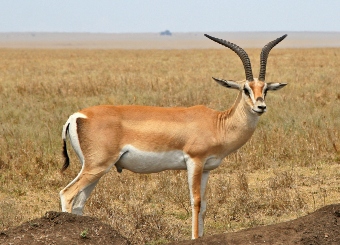
Grant's Gazelle ( Gazella granti )
Grant's gazelles are mostly identified by their colouring and long horns. They are sandy brown on the back, clearly demarcated from a lighter colour on the flanks and white belly, and white around the tail and hind legs. Horns are found on both sexes. These gazelles are often found in mixed groups alongside other herbivores. e.g. Wildebeest, Zebras and Thomson’s Gazelle. They may occur in large numbers (up to 500 individuals) in suitable areas. They exists in large numbers in Nyerere National Park, Ngorongoro Crater, and Serengeti National Park.

Honey Badger ( Mellivora capensis )
Honey badger also known as ratel is a mammal widely distributed in Africa, Southwest Asia and the Indian subcontinent. They get their name from their fondness for feeding on honey and honeybee larvae. They also eat insects, amphibians, reptiles, birds, and mammals, as well as roots, bulbs, berries, and fruits. Honey badgers hunt by locating their victims with their acute sense of smell. They will then dig with their razor-sharp claws to extract their prey. Most honey badgers are active throughout the day, though near human settlements they may prefer the cover of darkness. They are often seen alone, though it’s not uncommon to spot mating pairs. They are notorious for their pugnacious and fearless personality, and have been known to take on animals many times their own size.

Impala ( Aepyceros melampus )
Impala (Aepyceros melampus) is a medium-sized antelope found in eastern and southern africa. It is reddish-brown in colour with white hair inside the ears, over each eye and on the chin, upper throat, underparts and buttocks. A narrow black line runs along the middle of the lower back to the tail, and a vertical black stripe appears on the back of each thigh. Impalas are found at grassland and woodland edges, usually very close by water. They are both graze and browse and eats young grass shoots in the wet season and herbs and shrubs at other times. Best places to find impalas in Tanzania includes; Nyerere National Park, Ngorongoro Crater, and Serengeti National Park.
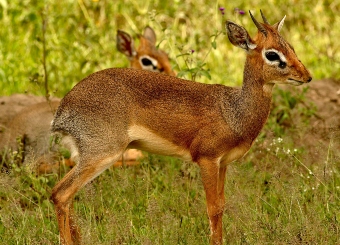
Kirk's Dik Dik ( Madoqua kirkii )
Kirk's dik dik is the most common of the two dik-diks found in Tanzania and is easily seen in Nyerere National Park, Ngorongoro Crater, Tarangire , and Serengeti National Park. The dik-dik is a tiny antelope, reddish-brown colour on the back, with lighter flanks and white belly. They are easily recognised by almost lack of a tail and the tuft of dark hair on the forehead. Horns (found only on males) are so short that they are often lost in the hair tuft. Dik-diks are highly nocturnal, and during the daytime seek shade to rest throughout the hottest parts of the day to help avoid the loss of valuable fluids.

Klipspringer ( Oreotragus oreotragus )
Klipspringer is a small antelope found in Eastern and Southern Africa. It is a small, sturdy antelope; standing about 50cm at the shoulder. They are easily recognised by their curious 'tip-toe' stance and the greenish tinge of their speckled coarse hair. Their horns are short and widely spaced. Klipspringer are most often seen on rocky outcrops, or in the grassland in the immediate vicinity, and when alarmed they retreat into the rocks for safety.Best places to find klipspringers in Tanzania includes; Nyerere National Park, Ngorongoro Crater, Tarangire , and Serengeti National Park.

Olive Baboons ( Papio cynocephalus anubis )
Olive Baboon also know as the Anubis Baboon, is one of the largest baboons, with an olive green/grey coat that covers its bodies and a black face. Olive baboons have the largest range of all baboons. They inhabit savannahs, steppes and forests and are very adaptable.They live in troops of males and females that consist of between 20 and 50 members, but sometimes these troops can consist of over 100 baboons. They feed on grass, seeds, leaves, cereals, fruit, tubers, small mammals, invertebrates and young birds.

Oribi ( Ourebia ourebi )
Oribi is a tall, slender antelope of medium-small size and sandy body color, with white undersides, upper throat, and mouth and ear linings. They are commonly found in grasslands maintained by fire or heavy grazing. Oribi prefers flats or gentle slopes and is commonest on open lawns of grass kept short by compaction, poor soils. They are relatively uncommon, and chances of spotting one is in Serengeti National Park.

Pangolin ( Manis temminckii )
Pangolins are bizarre-looking, nocturnal mammals covered in protective keratin scales. They are the only known mammals with this feature. When threatened, they roll up into a ball to protect themselves. They live in hollow trees or burrows, depending on the species. Pangolins diet consists of mainly ants and termites, which they capture using their long tongues. They tend to be solitary animals, meeting only to mate and produce a litter of one to three offspring, which are raised for about two years. Although they are one of Africa’s most elusive creatures and rarely seen, pangolins can be spotted in Serengeti National Park.
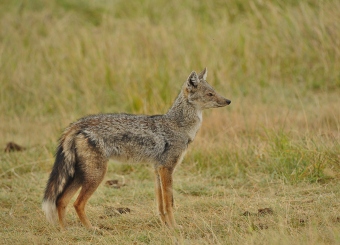
Side Striped Jackal ( Canis adustus )
Side striped jackal is shorter legged and shorter eared than other Jackals, it can be easily recognised by the white tip to its tail and by the poorly defined black and white stripes along the flanks. Commonly found in woodland and scrub areas. They mostly feed on invertebrates and small vertebrates eg; fish and gazelle fawns as well as fallen fruits, unripe maize, carrion and organic rubbish.

Slender Mongoose ( Herpestes sanguineus )
Slender mongoose also known as the black-tipped mongoose or the black-tailed mongoose, is a very common species of mongoose of sub-Saharan Africa. It is long-bodied, short-legged, partly arboreal mongoose, extremely variable in colour. The digits of the hands and feet splay readily and are armed with small but sharp color. The tip of the tail is usually black tipped. They are found in all wooden, Savannah, thicket and forest habitats and forest swamps. Slender mongoose feeds on rodents, insects, reptiles, frogs and birds.

Spotted Hyena ( Hyaena hyaena )
The spotted hyena also known as laughing hyena, is one of the most fascinating and successful carnivores in sub-Saharan Africa. In contrast to most other female mammals, the female hyena are male-like in appearance, larger than males, and substantially more aggressive this is beacuse of their social structure and an increase in testosterone in its fetal stages. Female hyenas are highly social and dominate the male hyenas, with the largest group sizes and most complex social behaviors. In Serengeti, spotted hyena territories are stable, but not large, averaging 12 hyenas per 100 sq km. Hyena is more often heard than seen, its loud long distance call carries for up to 5km and can be found throughout the extensive Serengetieco system. They are most active in the early hours of the morning at the time of the migration.

Spring Hare ( Pedetes capensis )
Spring Hare (pedetes) is a long-tailed, hopping rodent with long, soft fur, varying from warm reddish tints to yellow-grey above and white to pale tawny underneath. It has short forelegs but long, powerful hind legs and feet used for jumping. Spring hare feeds on fresh grasses, grazed to the ground stems, roots and storage bases of grasses, new sprouts of herbs and fruits. They sometimes eat insects, such as locusts. They feed only at night and within about 400m of burrow.

Straw Coloured Fruit Bat ( Eidolon helvum )
Straw coloured fruit bat also known as african straw coloured fruit bat is the second largest fruit bat in africa. They live in a wide range of habitats across sub-Saharan Africa. They prefers moist and dry tropical forests, because there is so much fruit, although they also eat blossoms and young shoots of silk-cotton trees but will use various other forest habitats and even urban areas. These bats are very strong fliers, with long, pointed wings built for endurance over agility. Because of this, they can’t manoeuvre in tight spaces and find their food in the more open upper canopy layer. Their bodies vary from the straw colour of their name to pale yellow or dark brown-grey. They are highly social species and travel in massive colonies of at least 100,000 bats.

Thomson's Gazelle ( Gazella thomsonii )
Thomson's gazelle is one of the best-known gazelles. It is named after explorer Joseph Thomson and is sometimes referred to as a "tommie". It is often confused with the much larger (38-80kgs) Grants Gazelle, however it is more easily identified by its thicker black tail, shorter horns and more obvious black stripe on the flank. Thomson’s gazelles prefer savannas and grassland habitats, particularly in the Serengeti region of Kenya and Tanzania.

Topi (Damaliscus lunatus jimela)
Topi (Damaliscus lunatus jimela) is a medium-sized antelope with a striking reddish-brown to purplish-red coat that is glossy, even iridescent in bright sunlight. Primarily lives in flood plains, but they are sometimes found in dry areas of open savanna and park woodland, taking to the shade during the heat of the day. They prefer flat lowlands, and can go without water for long periods of time only if they have access to green pastures. In Tanzania, they are mainly found in Serengeti National Park where they exists in large numbers. Their main predator is lion.

Vervet Monkey ( Cercopithecus aethiops )
Vervet Monkey is a small, black faced monkey with a greenish-olive or silvery-gray body, found in Serengeti. Vervet society is built on complex but stable social groups (called troops) of 10 to 50 individuals—mainly adult females and their immature offspring. They eats a primarily herbivorous diet, living mostly on Leaves and young shoots- but bark, flowers, fruit, bulbs, roots and grass seeds are also consumed. The mainly vegetarian diet is supplemented with insects, grubs, eggs, baby birds and sometimes rodents and hares.
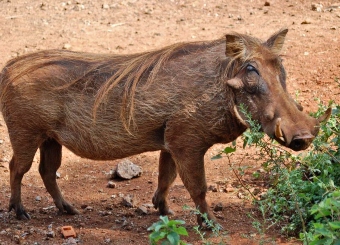
Warthogs ( Phacochoerus africanus )
Warthogs are the most common wild pig in Tanzania and the most frequently observed wild pig in Africa. They are distributed throughout the savannah and semi-arid areas of sub-saharan africa. They are often seen in family groups, with parents and piglets trotting briskly in a straight line with tails erect. Warthogs are herbivores and diurnal animals that spend much of their day foraging for food. Their most endearing habit is the way they turn tail and trot away with their thin tufted tails stuck straight up in the air like some antenna. Best places to see them in Tanzania are in Nyerere National Park, Ngorongoro Crater, Tarangire , and Serengeti National Park.
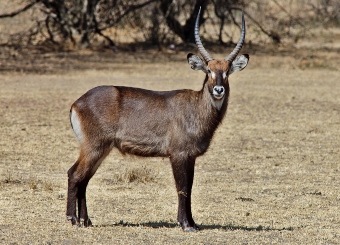
Waterbuck ( Kobus ellipsiprymnus )
Waterbuck also known as defassa waterbuck is a fairly solid animal and is easily recognisable by its thick, shaggy, dark brown coat and white inner thighs. The horns are present in males only which they use to defend themselves if attacked, and these curve gradually outwards then grow straight up to a length of about 75cm.The female and young ones move in vicinity of a number of territorial males,or may stay with one male. They feed on grass,reeds,and some foliage. It is fairly common and easily seen in Nyerere National Park, Ngorongoro Crater, Tarangire , and Serengeti National Park.
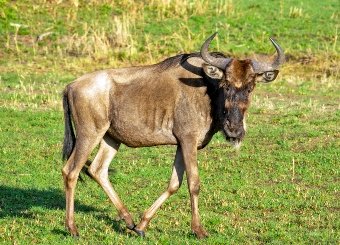
Wildebeest ( Connochaetes )
Wildebeest (also called gnu) are a member of the antelope family. The front end of their body is heavily built, while the hindquarters are slender with spindly legs. They have a gray coat and a black mane as well as a beard that can be black or white. There are several races of wildebeest. The species forming the large herds of the Serengeti-Mara ecosystem of Kenya and Tanzania is known as the western white-bearded wildebeest. Their favourite habitats are open woodlands and open grassy plains.